THE ORIGINS OF NATURAL PERFUMERY.
A sentimental introduction to the extraction of raw materials.
by Andrej Babicky, Certified Natural Perfumer
The new extraction methods, botanical discoveries, the search for new unusual raw materials helps to expand the perfumer's palette. In the past, the number of natural extracts was limited, but today progress and research offer us many more. Perhaps, the task of a natural perfumer could also be to discover and rediscover new or forgotten raw materials. Not being tied to the dictates of the market, we have the opportunity to experiment and experience returning to the roots of perfumery. And it is precisely the roots, rhizomes, tubers that are one of the building blocks of the art of perfumery: vetiver, iris, ginger, angelica, valerian, costus, calamus, nard and many others.
In my garden, I have a small pond where I grow water lilies. At the beginning of spring, a few years ago, I decided to empty it and clean it. The rhizomes of the water lilies had grown out of all proportion, intertwining with each other. While I was trying to take them off some of them broke. I was immediately struck by their particular smell: damp, muddy, to a certain extent aquatic with green and woody facets. At that precise moment, the idea was born. I left them to dry and try to do an extraction with alcohol. The result was surprising: the dried rhizome conveyed that earthy and humid scent, of mud or clay, of wet earth together with a mixture of woody, dry and vaguely spicy notes.
Another experiment was born by chance during a bonsai workshop.
Some participants were transplanting maples and had to cut some of the roots of the plants. The scent of these maple roots made me smile because it reminded me of freshly dug up carrots. Again, the final tincture was surprising.
Usually, the first attempt to extract a raw material is that of the tincture. I find it also the simplest one to do at home. The roots or rhizomes are cleaned and washed of earth residues, left to dry in the dark place or with the help of a fruit dryer machine and then placed in the previously sterilized glass jars. The amount of raw material is weighed and submerged by alcohol. After a few days, I check the procedure, smell the extract thus obtained and decide whether the exhausted material should be replaced or left to infuse for a longer period.
In addition to ginger, calamus, angelica you can use turnips, carrots, radishes, celery, asparagus not to forget truffles. From natural cosmetics, on the other hand, the rhizomes of peony, arrowroot, Hedychium spp, liquorice, burdock can be used. From popular and herbal medicine: burdock, Althea, Angelica, Inula racemosa, Geranium Robetianum, Polygonatum spp, Rheum spp, Bergenia Ligulata etc.
The list of plants would be very long but I would like to challenge you to find new ones, stimulate your creativity and inventiveness to create something new and why not also be innovative.
Pick up old herbaria, take a walk, let yourself be guided and inspired by your nose. Sniff out the treasures that Nature has to offer, be the “truffle dog” of the Natural Perfumery.
If you are interested in Learning Raw Material Extraction Methods, enrol for an 8 weeks online certified course with Andrej Babicky at the perfumefoundation.academy



 RSS Feed
RSS Feed